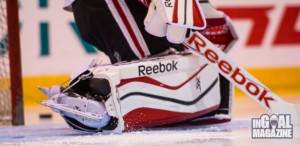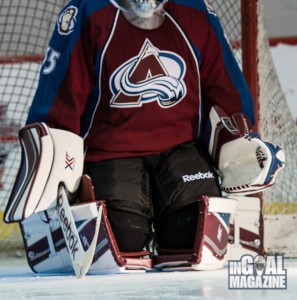The other day, I was reading one of my favorite goalie-related publications, InGoal Magazine. There was a fantastic article about some NHL tendys giving their thoughts on the new equipment sizing and some of the difficulties the changes pose. After reading the article and seeing some of the drastic reductions in size, I started thinking about the involvement of the Union and the type of representation that goalies are receiving during this type of transition.
There has been talk of allowing goalies up until the Olympic break to comply with the new rules, and further talk of revisiting the measurements in the off-season (not to see if they are effective, mind you, but to take another crack at reductions). After examining all the information from the article and investigating further into the compromise made with regard to the reduction formula, I arrived at the conclusion that goalies are not being advocated for properly in the new-NHL.
For many years now, the NHL has been implementing perspective rule changes in the lower leagues to determine if they will improve the product at the highest level. Delayed off-sides, hybrid icing, removing the two line pass, etc. have been tested out in either the AHL or Junior leagues to determine viability in the NHL. There has presumably been empirical data, input from players, coaches, officials and league administrators lending support for NHL implementation. This probably the most effective way to determine the viability of policies that could have a profound impact on the NHL game.
Since Lockout II in ‘04-‘05, there have been three rounds of goalie pad reductions and the implementation of the trapezoid to limit goaltenders’ ability to play the puck. All of these policies (to my knowledge) were implemented immediately at the NHL level as a result of collective bargaining sessions between the league and NHLPA. Where was the testing? Where was the determination that these reductions were not only safe, but accomplished the policy goals that led to their implementation?
The league is obviously after more goals. Especially with bringing the allure of outdoor hockey to the masses with six outdoor games next season. The best case scenario would be for all six of these games to be absolute barnburners, which would help attract the casual fan and bring more revenue to the sport. This is a noble cause, but one that is being rushed out, seemingly without the proper understanding of how this will effect not only playing style, but safety.
The biggest thing that the Doug Wilsons’ of the world fail to recognize, is that if you take away the goalie’s thigh-rise, you aren’t exposing a gaping goal between a tender’s legs that will lead to a glut of goal scoring. You are exposing the goaltender’s knees. When a goalie drops into a butterfly, his knees are pulled together to create the splay of the legs. Taking away the top of the pads just exposes the knee-caps (one of the most painful places to be struck by frozen rubber). Now, the league wants to reduce the size and materials in the knee pads that goalie’s use to combat this type of injury. Many NHL goalies are now wearing Swiss-made carbon fiber knee pads which, in light of the thigh-rise reductions are almost essential. Just look at what the new sizing rules have done to JS Giguere (see below, but I would argue his pants and chest protector are far more problematic than his leg pads).
The fact that the Player’s Association allowed this to happen without so much as a fight got me pondering a fairly glaring conflict of interest that exists within the Union itself. By virtue of their membership into the NHLPA, the Union has what’s known as a fiduciary duty to the players. This is a special legal relationship which basically requires the PA to act in the player’s best interest. Here’s where the conflict comes in. At any given time, there are 60 NHL goaltending jobs. As opposed to over 600 non-goaltenders. With tenders making up less than 10% of the league, it makes sense that the PA will focus more heavily on the rights of other players.
The problem is in the instance of equipment reductions and general limitations on the goaltending position, their “best interests” are diametrically opposed to the players. The mission statement of the Union is essentially to advance the interests of the players and give them bargaining and earning power as they ply their trade in the league. The Union will attempt to increase salaries for future players and advocate for their financial benefit in collective bargaining settings. However, what is the primary factor increasing a player’s overall value and earning potential? The answer boys and girls, is goals. Goals pay the bills. Goals drive revenue, goals create lucrative contract situations and bidding wars.
So if the PA is in the business of advancing the financial bargaining power of the players, doesn’t shrinking goalie pads (allegedly) advance that goal? The PA caved far too easily to league pressure (who’s current mandate is “more goals”) and didn’t seem to seek any empirical evidence that these reductions would not endanger goaltender safety or that it would actual lead to the increased goal scoring that the league so craves.
Additionally, Kay Whitmore, the top goaltending cop for the league, is a dinosaur. His NHL playing days ended in the mid-90’s and his career proper ended before Lockout II. His entire professional career was played in a bygone era of equipment and a decreased environment of goaltender efficacy. He is also employed by the league to advance their directives. It creates a sense of faux-fairness simply because he played the position. But, at the end of the day he is still an employee of the NHL.
NHL Goaltenders need a specific advocacy body to keep their interests relevant without regard to the rest of the league’s players. Currently, Cory Schneider is the player rep who gives goaltenders a voice during these sessions. He took the mantle from new teammate Marty Brodeur and his successor, Ryan Miller. While I have no doubt that Schneider is an intelligent person, as I’m sure Miller and Brodeur were as well, but is he really equipped to deal with the NHL front office and their army of labor lawyers? The fact that there have been three unproven rounds of equipment reduction, restrictions of on-ice conduct and not to mention how Milan Lucic’s vicious hit on Miller himself sparked more debate than outrage, simply goes to show the lack of meaningful advocacy goaltenders receive from the Player’s Association.
Eventually, something will have to give. Either the equipment is going to be slashed to bone and the entire position will ultimately change, or guys are going to start dropping in droves with various injuries. This isn’t even to discuss the inherent unfairness of the measurement calculations or collateral safety issues. Far too often the interests of the goaltending community are inconvenient or directly conflicting with those of the rest of the league’s players. Unfortunately, no one seems to understand the conflict within the Union and until they do, goalies will continue to be on the wrong end of goal oriented policy decisions. NHL goaltenders deserve better.
Share:
More About:Business of Hockey Goaltending


